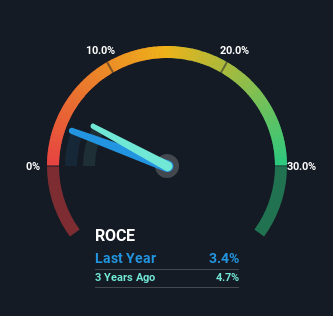- Hong Kong
- /
- Consumer Durables
- /
- SEHK:229
Raymond Industrial (HKG:229) Has Some Difficulty Using Its Capital Effectively

If you're looking at a mature business that's past the growth phase, what are some of the underlying trends that pop up? A business that's potentially in decline often shows two trends, a return on capital employed (ROCE) that's declining, and a base of capital employed that's also declining. Trends like this ultimately mean the business is reducing its investments and also earning less on what it has invested. Having said that, after a brief look, Raymond Industrial (HKG:229) we aren't filled with optimism, but let's investigate further.
Return On Capital Employed (ROCE): What Is It?
Just to clarify if you're unsure, ROCE is a metric for evaluating how much pre-tax income (in percentage terms) a company earns on the capital invested in its business. Analysts use this formula to calculate it for Raymond Industrial:
Return on Capital Employed = Earnings Before Interest and Tax (EBIT) ÷ (Total Assets - Current Liabilities)
0.034 = HK$22m ÷ (HK$854m - HK$208m) (Based on the trailing twelve months to December 2022).
So, Raymond Industrial has an ROCE of 3.4%. Ultimately, that's a low return and it under-performs the Consumer Durables industry average of 7.7%.
Check out our latest analysis for Raymond Industrial

Historical performance is a great place to start when researching a stock so above you can see the gauge for Raymond Industrial's ROCE against it's prior returns. If you want to delve into the historical earnings, revenue and cash flow of Raymond Industrial, check out these free graphs here.
How Are Returns Trending?
There is reason to be cautious about Raymond Industrial, given the returns are trending downwards. About five years ago, returns on capital were 7.3%, however they're now substantially lower than that as we saw above. Meanwhile, capital employed in the business has stayed roughly the flat over the period. This combination can be indicative of a mature business that still has areas to deploy capital, but the returns received aren't as high due potentially to new competition or smaller margins. So because these trends aren't typically conducive to creating a multi-bagger, we wouldn't hold our breath on Raymond Industrial becoming one if things continue as they have.
The Key Takeaway
In summary, it's unfortunate that Raymond Industrial is generating lower returns from the same amount of capital. Despite the concerning underlying trends, the stock has actually gained 9.9% over the last five years, so it might be that the investors are expecting the trends to reverse. Regardless, we don't like the trends as they are and if they persist, we think you might find better investments elsewhere.
If you'd like to know more about Raymond Industrial, we've spotted 3 warning signs, and 1 of them makes us a bit uncomfortable.
While Raymond Industrial may not currently earn the highest returns, we've compiled a list of companies that currently earn more than 25% return on equity. Check out this free list here.
If you're looking to trade Raymond Industrial, open an account with the lowest-cost platform trusted by professionals, Interactive Brokers.
With clients in over 200 countries and territories, and access to 160 markets, IBKR lets you trade stocks, options, futures, forex, bonds and funds from a single integrated account.
Enjoy no hidden fees, no account minimums, and FX conversion rates as low as 0.03%, far better than what most brokers offer.
Sponsored ContentNew: AI Stock Screener & Alerts
Our new AI Stock Screener scans the market every day to uncover opportunities.
• Dividend Powerhouses (3%+ Yield)
• Undervalued Small Caps with Insider Buying
• High growth Tech and AI Companies
Or build your own from over 50 metrics.
Have feedback on this article? Concerned about the content? Get in touch with us directly. Alternatively, email editorial-team (at) simplywallst.com.
This article by Simply Wall St is general in nature. We provide commentary based on historical data and analyst forecasts only using an unbiased methodology and our articles are not intended to be financial advice. It does not constitute a recommendation to buy or sell any stock, and does not take account of your objectives, or your financial situation. We aim to bring you long-term focused analysis driven by fundamental data. Note that our analysis may not factor in the latest price-sensitive company announcements or qualitative material. Simply Wall St has no position in any stocks mentioned.
About SEHK:229
Raymond Industrial
Engages in the manufacture and sale of electrical home appliances in Asia, Europe, Latin America, North America, and internationally.
Flawless balance sheet established dividend payer.
Market Insights
Community Narratives



